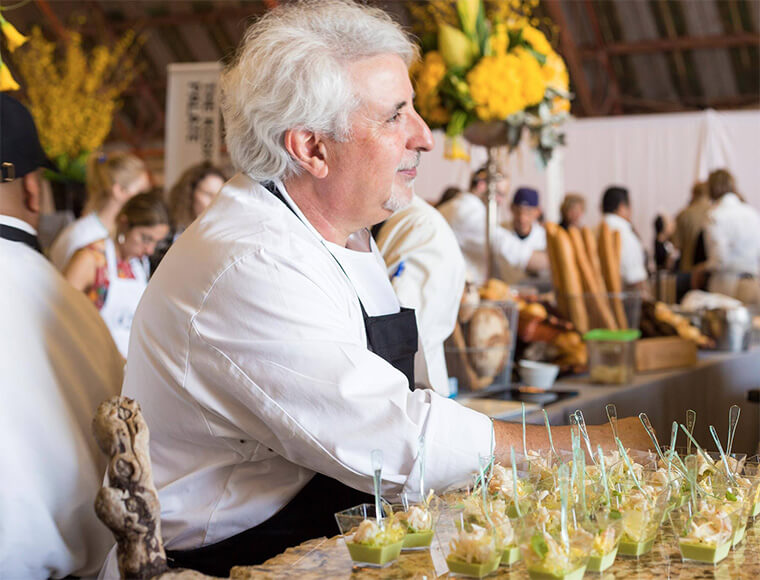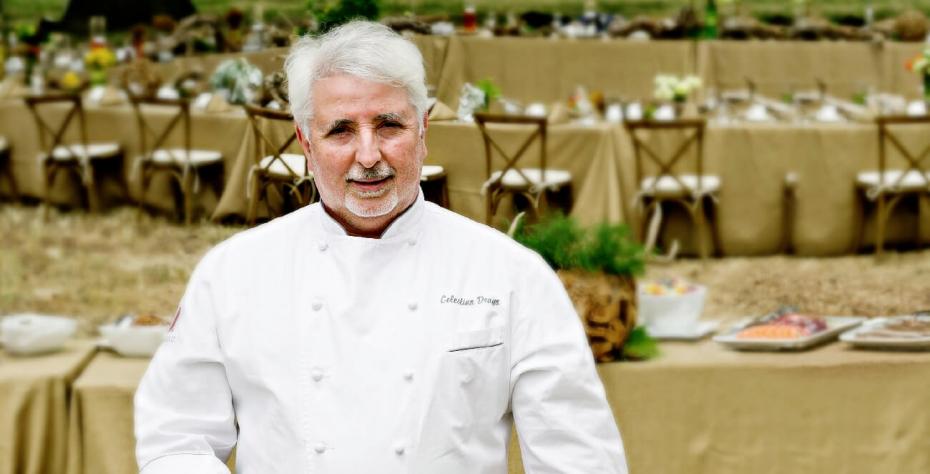It could have been a completely different story. Celestino Drago, who comes from the Province of Messina (Sicily), might have become a successful mechanic at Piaggio.
Instead of tinkering with Vespa scooters’ engines, all day long, he made the choice to sweat blood in the kitchen. Today, after a thirty-seven long career in Los Angeles, chef and restaurateur, Celestino, together with three of his brothers and one sister, manage an “empire”, encompassing fourteen among Italian restaurants, catering services and, even, a bakery.
So, what are you waiting for? Wrap that napkin around your neck and indulge yourself with a delicious plate of pasta.

Please, introduce yourself. What is your cultural background? Share with us your earliest memories in the kitchen?
I’m Celestino Drago, chef and owner of multiple restaurants. I am the oldest of eight children and we were raised in the small town of Galati Mamertino, in Sicily’s Messina area.
My family is mostly made of farmers and everybody believes that ingredients have to be of supreme quality. Everything was homemade from scratch and, literally, only salt and sugar were bought at the grocery.
I grew up, helping my parents to pick up the olives for the olive oil, as well as making the wine and the cheese. I learned the full process from the soil to the finished products.
I remember how, during wintertime, my mom told my brothers and I to light the burner, at five o’clock in the afternoon, and put the pot of water on top. This was so that, by the time she was back home, she could have a head start and cook pasta faster.
Italian way of cooking stands out for its simplicity. My mom was no exception. Pasta and bread were always an essential part of our meals, while dessert were not common and, usually, replaced by fruit.
My mom was preparing tomato sauce all the time, and, as a child, I used to cut a little piece of sausage, or cheese, and drop it into the sauce, on the sly. Somehow, back then, I already felt the impulse to make things a little different, with a dash of creativity.
Could you tell us about your personal journey from Sicily to L.A. and how, in the early 80s, you launched a number of high-end Italian restaurants, together with three of your brothers, Tanino, Calogero and Giacomino? How was your adjustment to the city?
As I was growing up, I didn’t want to keep studying. My parents were disappointed, but I finally compromised with them and went to study at the mechanical school in Pisa, Tuscany.
I used to hang out with people working at a restaurant, called “Pierino”, in Tirrenia (parish of Pisa) and asked if I could spend my time off, helping them in the kitchen. Soon, I developed a passion for cooking. As I finished school, I was one of the few to receive a job offer from Piaggio (in Pontedera, province of Pisa), the two wheeled motor vehicles company, famous for its “Vespa” scooter.
When I turned down the offer and decided to stay at the restaurant, the other chefs and the owner couldn’t believe that I made that choice. They took me under their wings and, by the age of twenty, I was already their chef.
In 1979, the L.A. based Italian restaurant, Orlando Orsini, was scouting for some young talented chefs, who were able to cook Tuscan dishes. They offered me a round trip ticket to Los Angeles and the opportunity to try out the job in the kitchen for a couple of weeks. I enjoyed the experience and ended up staying here since.
As a youngster, I really liked being in Hollywood. The early eighties were such a lively and crazy time. As far as Italian cuisine, in most cases, Italians and Americans alike offered a “fake” food version, since they didn’t use the proper ingredients, or have a real expertise. I wanted to stick to my authentic way of cooking, whose essential component is the high quality of its ingredients.
Back then, there was a shortage of Italian ingredients in California. For instance, it was impossible to find the Arborio short-grain rice, or the red radicchio. Basil was not available all year round, but only for two months during summer.
Eventually, the situation changed. Local farmers started to plant Italian seed varieties and to grow arugula and basil, just to name a few.
Upon spending two and a half years in Orlando Orsini, I went to work at another restaurant, in Beverly Hills. However, I felt my creativity was restrained there and I moved again to an historic Italian restaurant on Melrose Place, called Chianti. Somehow, I was never fully satisfied, since I had the dream to open my own restaurant.
I gradually built up my connections and, finally, in 1985, I opened my first restaurant, called Celestino, on South Beverly Dr.
I didn’t do this alone because I had help from Calogero, one of my younger brothers, who, upon completion of a hospitality training institute in Sicily, joined me here in 1984. While he handled the front of house, I was leading in the kitchen. Soon after, two of my other brothers, Tanino and Giacomino, joined us at our restaurant.
Afterwards, each of us followed his own path and, currently, among the four of us we operate fourteen restaurants, catering services and other food production activities.
Ten years ago, my sister Carolina moved here with her husband, Armando, and both of them joined our business. In 1996, I married my long-time girlfriend Leslie and we build a beautiful family, with our two daughters Olivia and Francesca.
What are your main culinary influences and your “forte”?
My main goal is to provide seasonal food, always. I love cooking game, like duck and wild boar. I’m also a big believer in organic, not processed food. I grow my own organic produce in Santa Barbara County, at Pence Ranch, which supplies a large percentage of seasonal vegetables to my restaurants.
I actually don’t have a “forte,” but always try my best with what I have at hand.
You are Executive Chef/owner of Drago Centro, Il Pastaio, Drago Bakery, Drago Air Catering and Drago Catering/Special Events. How do they differ from one another?
My main philosophy is that I don’t want to reinvent the wheel. However, in a city like L.A., you need to be creative.
Soon after I relocated my restaurant, Celestino, to Santa Monica, and renamed it Drago, I felt the need to launch an unpretentious trattoria, specializing in pastas, risottos, carpaccio and fresh salads. We named it, Il Pastaio (Beverly Hills). The main attraction was and still is the handmade fresh pasta, even if today we’ve opened up our menu to other main courses.
Among the dishes, served in Drago, eight were Sicilian. The press seemed to focus exclusively on those, so I had then the idea to open a Sicilian restaurant, called L’Arancino. There was the general assumption that only food from northern Italy was a real delicacy, while plates from southern Italy were extra seasoned and spicy.
That was a wrong and unfounded perception and my mission was to prove it. I had the menus written in Sicilian dialect, as well as “unearthing” traditional Sicilian dishes, which not even Sicilians ate any more.
In 2009, I decided to open Drago Centro (Downtown Los Angeles), which offers an upscale service. The astonishing setting marries a contemporary design with an additional touch of finesse, represented by the demonstration kitchen housed in what was once the vault of City National Bank.
Everything, from the food presentation to the chinaware to the service, has been elevated from my previous restaurants. We reinvented some traditional dishes, like “Pizzoccheri della Valtellina,” traditionally heavy, by employing a Fontina cheese fondue, as well as cabbage and potatoes, cooked separated. The final plate is much lighter than its Aostan counterpart.
Another example is, “Spaghetti al pesto alla Trapanese,” with hand-cranked green pasta, which combines almonds, fried tomato skin, basil pesto, and shaved Parmigiano-Reggiano on top.
Drago Bakery, originally named Dolce Forno Bakery, which has been initially supplying bread to all Drago restaurants, now serves a large portion of Southern California’s restaurant, cafes, hotels, and also individual customers, who wish to taste fresh-made pasta, pastries, and bread.
Last but not least, my three brothers and I are venturing in a new project, commissioned by the Petersen Automotive Museum, on the corner of Fairfax Avenue and Wilshire Boulevard.
We’re going to have a new upscale restaurant, Drago at the Petersen, serving dinner as well as a trattoria-like spot for lunch.





























